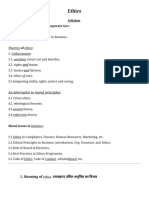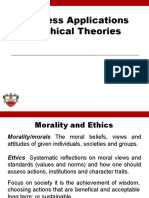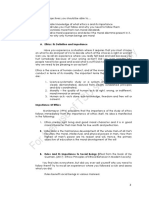0 ratings0% found this document useful (0 votes)
1 viewsCSR 2
CSR 2
Uploaded by
m3914815Copyright:
© All Rights Reserved
Available Formats
Download as DOCX, PDF, TXT or read online from Scribd
CSR 2
CSR 2
Uploaded by
m39148150 ratings0% found this document useful (0 votes)
1 views4 pagesCopyright
© © All Rights Reserved
Available Formats
DOCX, PDF, TXT or read online from Scribd
Share this document
Did you find this document useful?
Is this content inappropriate?
Copyright:
© All Rights Reserved
Available Formats
Download as DOCX, PDF, TXT or read online from Scribd
Download as docx, pdf, or txt
0 ratings0% found this document useful (0 votes)
1 views4 pagesCSR 2
CSR 2
Uploaded by
m3914815Copyright:
© All Rights Reserved
Available Formats
Download as DOCX, PDF, TXT or read online from Scribd
Download as docx, pdf, or txt
You are on page 1of 4
“(Ethical Principles, Quick Tests & Decision-Making Guidelines)”
Primary Stakeholders vs Secondary stakeholders: The primary stakeholders lies within
the boundary of the firm, while secondary stakeholders lies outside.
Primary includes; (Owners, Suppliers, Customers, Employees)
Secondary includes; (Special-interest group, Consumer group, Environmental
groups, Society at large, Media, Local community groups)
Ethical Reasoning and Moral decision-making:
Ethical reasoning helps determine and differentiate between right thinking,
decisions, and actions and those that are wrong, hurtful, and/or harmful—to
others and to ourselves.
The proper role of ethical reasoning is to highlight acts of two kinds;
Those that enhance the well-being of others that warrant our praise.
Those that harm or diminish the well-being of others and thus warrant our
criticism.
Ethical reasoning involves thinking before acting and gaining an understandings of
motives before consequences occur.
Three Criteria in Ethical Reasoning:
1. Moral reasoning must be logical. Assumptions and premises, both factual and
inferred, used to make judgments should be known and made explicit.
2. Factual evidence cited to support a person’s judgment should be accurate,
relevant, and complete.
3. Ethical standards used in reasoning should be consistent. When inconsistencies are
discovered in a person’s ethical standards in a decision, one or more of the
standards must be modified.
Moral Responsibility Criteria: Individuals are morally responsible for the harmful
effects of their actions when.
They knowingly and freely acted or caused the act to happen and knew that the act
was morally wrong or hurtful to others.
They knowingly and freely failed to prevent a harmful act, and they knew it would
be morally wrong for a person to do this.
Ethical Principles and Decision-Making: Following are the ethical decision-making
principles.
1. Ethical Relativism: (A Self-Interest Approach)
People set their own moral standards for judging their actions.
This form of relativism is also referred to as (naive relativism.)
The point behind this principle is that individual standards are the basis of moral
authority.
It also extends to cultures I:e (Cultural Relativism)
Cultural relativism argues that, (When in Rome, Do as Romans do)
What is morally right for one society or culture may be wrong for another.
Moral standards vary from one culture to another
Cultural relativists would argue that firms and business professionals doing
business in a country are obliged to follow that country’s laws and moral codes.
2. Utilitarianism: (A Consequentialist [Result Based] Approach
The basic utilitarian view is that an action is judged as right or good on the basis of
its consequences
Utilitarianism includes the following clauses;
An action is morally right if it produces the greatest good for the greatest
number of people.
An action is morally right if the net benefits over costs are greatest for all
affected, compared with the net benefits of all other possible choices
An action is morally right if its benefits are greatest for each individual and if
these benefits outweigh the costs and benefits of the alternatives.
There are also two types of criteria used in utilitarianism. (Rule-based and Act-
based)
Rule-based utilitarianism argues that general principles are used as criteria for
deciding the greatest benefit to be achieved from acting a certain way.
Act-based utilitarians, on the other hand, analyze a particular action or behavior to
determine whether the greatest utility or good can be achieved.
Problems of the theory:
No agreement exists about the definition of “good” for all concerned.
No agreement exists about who decides
The actions are not judged, but rather their consequences
How are the costs and benefits of non-monetary stakes, such as health, safety, and
public welfare measured?
Utilitarianism does not consider the individual. It is collective for whom the
greatest good is estimated
The principles of justice and rights are ignored in utilitarianism
3. Universalism: (A Deontological [Duty Based] Approach
It states that the ends do not justify the means of an action, the right thing must
always be done
The term “(Deontology)” is derived from the Greek word (Deon) or duty
It is also known as (Non-Consequentialist Theory)
Regardless of consequences, this approach is based on universal principles, such as
justice, rights, fairness, honesty, and respect
This contains two clauses;
A person should choose to act if and only if that person thinks every person on
earth would choose the same for themselves.
In an ethical dilemma, treat everyone involved equally
Problems of the theory:
These principles are imprecise and impractical.
It is hard to resolve conflicts
Not prioritizing one’s own duty
4. Rights: (Entitlement Based Approach) Following are the different types of rights are
included in this theory.
Legal Rights; These are limited to a particular legal system and jurisdiction. E:g;
(The right to life, liberty, and the pursuit of happiness, and the right to freedom of
speech.)
Moral/Human Rights; These are universal rights and based on norms in every
society E:g; (The right not to be enslaved, right to work, right to education)
Contractual Rights; It mutually binds duties of two parties that are based on a legal
system with defined transactions and boundaries.
There are different clauses included in the rights;
The contract should not commit the parties to unethical conduct
Both parties should freely enter the contractual agreement
Individuals should not misrepresent or misinterpret facts in the contract
Both individuals should have complete knowledge of the contract before they
are bound by it.
Negative Rights; It refers to the duty of others that not to interfere with your right.
E:g; (If someone has right to freedom of speech, others have the duty not to
interfere with that right.)
Positive Rights; It refers to the duty on others to provide for your needs to achieve
your goals. E:g; (The parents have the right on their child to provide him/her better
educational opportunities)
Problems of theory:
Manipulate, Selfish, Unjust political interests.
Protection of one’s right at expense of others
Limits of rights are not defined
5. Justice Theory: (Compensations, Procedures, Retributions)
The principle of justice deals with fairness and equality.
The moral authority that decides what is right and wrong concerns the fair
distribution of opportunities, as well as hardships to all.
There are two principles of justice;
The first principle states that all individuals should be treated equally.
The second principle states that justice is served when all persons have equal
advantages to society’s opportunities and burdens.
Problems of theory:
Who decide who is right, who is wrong
Who has moral authority to punish
Opportunities and burden can they be fairly distributed.
6. Virtue Ethics Theory: (Character-Based Virtues)
It is grounded in our character and personality traits that are deeply rooted
It emphasizes (moral character), in compare to (moral rules and consequences.)
Problems of theory:
It fails to adequately address dilemmas which arise in applied ethics.
It cannot correctly assess the changes in personality due to tragic situations.
This theory does not provide the list of prohibited tasks.
Character traits change, and unless we stay in practice, we risk losing our
proficiency in these areas.
There is the problem of moral back sliding.
You might also like
- Peikoff-Why Should One Act On PrincipleDocument10 pagesPeikoff-Why Should One Act On PrinciplePaulo ResendeNo ratings yet
- Aint Nobodies Bussiness If You DoDocument415 pagesAint Nobodies Bussiness If You DoJosh Heller100% (1)
- Rehabilitation Theory PDFDocument4 pagesRehabilitation Theory PDFKevin Rey CaballedaNo ratings yet
- Normative Ethics Readings19 20 1Document27 pagesNormative Ethics Readings19 20 1JHUZELL DUMANJOGNo ratings yet
- Case Study Ethical Paper:: Bs Crim 1-BDocument7 pagesCase Study Ethical Paper:: Bs Crim 1-BJonel Naquita100% (1)
- CSR 2Document4 pagesCSR 2m3914815No ratings yet
- Bab2 .ETHICAL PRINCIPLES IN BUSINESSDocument22 pagesBab2 .ETHICAL PRINCIPLES IN BUSINESSWulan Rezky AmalyaNo ratings yet
- Normative Ethics Readings (19-20)Document27 pagesNormative Ethics Readings (19-20)Adrian BrillantesNo ratings yet
- Lecture-3-20032022-080910pmDocument19 pagesLecture-3-20032022-080910pmmichellemalik010No ratings yet
- Utilitarianism & Related Concepts: Sub: Ethics & CSR By: Akanksha RawatDocument28 pagesUtilitarianism & Related Concepts: Sub: Ethics & CSR By: Akanksha RawatVandana Řwţ100% (1)
- Business Ethics Chapter 3Document28 pagesBusiness Ethics Chapter 3Usman DastiNo ratings yet
- Overview of Ethics Written Report 1Document7 pagesOverview of Ethics Written Report 1Aron Jay MejiaNo ratings yet
- The Utilitarian ApproachDocument4 pagesThe Utilitarian Approachanon_972987121No ratings yet
- Formal GuidelinesDocument3 pagesFormal GuidelinesKARL LOUWEN ALILIONo ratings yet
- Phis Lecture-1Document6 pagesPhis Lecture-1Fatima SerranoNo ratings yet
- Ethical Principle, Quick Test and Decision MakingDocument4 pagesEthical Principle, Quick Test and Decision MakingAbdullah NomanNo ratings yet
- Aman Jain Ethics Short Notes and LinksDocument16 pagesAman Jain Ethics Short Notes and LinksAman JainNo ratings yet
- Ethics Notes-Introduction and TheoriesDocument5 pagesEthics Notes-Introduction and Theoriesoroniallan02No ratings yet
- Principles of EthicsDocument30 pagesPrinciples of EthicsBharat RaoNo ratings yet
- Boatright Ch3Document49 pagesBoatright Ch3monaNo ratings yet
- ETHICSDocument3 pagesETHICSlalabarcomamolinaNo ratings yet
- Ethical Theories and FrameworkDocument5 pagesEthical Theories and FrameworkshannonnyamburaNo ratings yet
- Hyundai Ethical Case StudyDocument10 pagesHyundai Ethical Case StudyAnuj SharmaNo ratings yet
- Home Markkula Center For Applied Ethics Ethics Resources Ethical Decision Making Thinking EthicallyDocument4 pagesHome Markkula Center For Applied Ethics Ethics Resources Ethical Decision Making Thinking EthicallyMark Charle Mana IINo ratings yet
- 2.2 Decision Making - A Framework For Thinking EthicallyDocument4 pages2.2 Decision Making - A Framework For Thinking Ethicallywiwid permamaNo ratings yet
- The Ethics of ManagementDocument3 pagesThe Ethics of Managementutcm77No ratings yet
- MoralDocument79 pagesMoralZemeneNo ratings yet
- Business Applications of Ethical TheoriesDocument27 pagesBusiness Applications of Ethical TheoriescrimsengreenNo ratings yet
- Chapter 3Document23 pagesChapter 3Muhamad Irfan Abd HalimNo ratings yet
- Ethics TheoriesDocument55 pagesEthics TheoriesMichael MbuviNo ratings yet
- 00004ethics ReportDocument36 pages00004ethics ReportDominic BocoNo ratings yet
- Business Ethics and Normative PhilosophyDocument21 pagesBusiness Ethics and Normative Philosophynamitarajput100% (1)
- Lecture 2 - Ethical Theories of Business EthicsDocument32 pagesLecture 2 - Ethical Theories of Business EthicsAishviniNo ratings yet
- Framework On Thinking EthicallyDocument3 pagesFramework On Thinking EthicallyLabingla VingyuuuNo ratings yet
- Ethics QuizDocument3 pagesEthics QuizathierahNo ratings yet
- How To Think and Act Ethically Ethical FrameworkDocument5 pagesHow To Think and Act Ethically Ethical Frameworksureshml1710pNo ratings yet
- Introduction To Ethical TheoriesDocument31 pagesIntroduction To Ethical TheoriesSyed AmirNo ratings yet
- Cyber NotesDocument61 pagesCyber NotesEmma mutaurwaNo ratings yet
- Ethical Theories - Ethical DilemmasDocument28 pagesEthical Theories - Ethical DilemmasrohanNo ratings yet
- Velasquez C2Document22 pagesVelasquez C2Eugenia TohNo ratings yet
- A Framework For Ethical Decision MakingDocument15 pagesA Framework For Ethical Decision MakingNarendra KumarNo ratings yet
- Assignment.1 (8420)Document19 pagesAssignment.1 (8420)zeeshan1kbNo ratings yet
- Article Two of TwoDocument4 pagesArticle Two of TworailamutukaNo ratings yet
- Business Ethics Study MaterialDocument8 pagesBusiness Ethics Study MaterialSandeshKumarNo ratings yet
- Exam Prep 2021Document6 pagesExam Prep 2021kefas PinehasNo ratings yet
- Chapter 1 Lesson 1.3 Codes of Right ConductDocument8 pagesChapter 1 Lesson 1.3 Codes of Right ConductSyrill CayetanoNo ratings yet
- Tutorial 3Document5 pagesTutorial 3Bks ParajuliNo ratings yet
- EthicsDocument11 pagesEthicsMd. Moshiur Rahman MugdhoNo ratings yet
- Christian Ethics 4 Final Paper Aug 24Document4 pagesChristian Ethics 4 Final Paper Aug 24RinielNo ratings yet
- !VRevised Supp Document Phi1370 Midterm1 Q&aDocument36 pages!VRevised Supp Document Phi1370 Midterm1 Q&asunnypikeNo ratings yet
- Buiness Ethics Chap 2 (Lecture 4) 07.10.2024Document12 pagesBuiness Ethics Chap 2 (Lecture 4) 07.10.2024Marium HasanNo ratings yet
- Assignment-2: Govt. Engg. College AjmerDocument12 pagesAssignment-2: Govt. Engg. College AjmersaurabhNo ratings yet
- EthicsDocument5 pagesEthicsRicardo IbañezNo ratings yet
- Deontology - Duty-Based Ethics (Kant) : ContributorsDocument15 pagesDeontology - Duty-Based Ethics (Kant) : ContributorsGilyn NaputoNo ratings yet
- AAU Civic and Ethical Education AssignmentDocument16 pagesAAU Civic and Ethical Education AssignmentnahNo ratings yet
- B.ethics 1Document18 pagesB.ethics 1vani3826No ratings yet
- Unit 3 Lecture Notes EthicsDocument100 pagesUnit 3 Lecture Notes EthicsSimphiwe KarrenNo ratings yet
- Ethicss Bba ViDocument11 pagesEthicss Bba Visharma.harshita2019No ratings yet
- Business EthicsDocument119 pagesBusiness EthicsManuj SomaniNo ratings yet
- Dr. Ram Manohar Lohiya National Law Unversity, Lucknow: "Ethics in Education"Document13 pagesDr. Ram Manohar Lohiya National Law Unversity, Lucknow: "Ethics in Education"Saroj adityaNo ratings yet
- Decoding Right from Wrong: 7 Key Strategies for Ethical Decision-MakingFrom EverandDecoding Right from Wrong: 7 Key Strategies for Ethical Decision-MakingNo ratings yet
- Ed 201Document4 pagesEd 201ninaladaerlinda1957No ratings yet
- Powerpoint 9 Defences 1Document21 pagesPowerpoint 9 Defences 1JelisaNo ratings yet
- Is It Better To Be Feared Than LovedDocument2 pagesIs It Better To Be Feared Than Lovedavnikacik33% (3)
- Lesson 2 Thomas Aquinas and Natural Law TheoryDocument6 pagesLesson 2 Thomas Aquinas and Natural Law TheoryLala BubNo ratings yet
- PP v. Lol-Lo and SarawDocument2 pagesPP v. Lol-Lo and SarawJuvylynPiojo100% (1)
- Pub - Moral Foundations An Introduction To Ethics PDFDocument596 pagesPub - Moral Foundations An Introduction To Ethics PDFNelson Elbert Delos ReyesNo ratings yet
- Rama Coomaraswamy - The Problems That Result From Locating Spirituality in The PsycheDocument16 pagesRama Coomaraswamy - The Problems That Result From Locating Spirituality in The PsycheTur111No ratings yet
- The SPL Journal of Literary Hermeneutics: Revisiting Indian Philosophy: A Study of Ethical Codes inDocument12 pagesThe SPL Journal of Literary Hermeneutics: Revisiting Indian Philosophy: A Study of Ethical Codes invanshikayadav0612No ratings yet
- Evidence AssignmentDocument19 pagesEvidence AssignmentAKanksha ChOudhary100% (3)
- People v. ConoradoDocument18 pagesPeople v. Conoradosuperwezowski7No ratings yet
- People vs. SevillaDocument2 pagesPeople vs. Sevillaanon_736038228100% (1)
- Legal ObligationDocument31 pagesLegal ObligationRose MonsantoNo ratings yet
- Review On Sociology of Crimes and Ethics 15% Introduction To CriminologyDocument9 pagesReview On Sociology of Crimes and Ethics 15% Introduction To CriminologyRico T. Musong100% (2)
- Chapter 1 & Chapter 2 Sosiologi Tahap IDocument11 pagesChapter 1 & Chapter 2 Sosiologi Tahap ICitraNo ratings yet
- Unit 5Document8 pagesUnit 5Himanshu Dargan67% (3)
- DK Basu Versus State of WestBengalDocument12 pagesDK Basu Versus State of WestBengalbansNo ratings yet
- Baluyot vs. TalionDocument2 pagesBaluyot vs. TalionJan Rhoneil SantillanaNo ratings yet
- Conflicts of Laws OutlineDocument56 pagesConflicts of Laws Outlinekristin1717No ratings yet
- 10.CalvetAlm JOEP FINAL PDFDocument22 pages10.CalvetAlm JOEP FINAL PDFArtika Enggar DwiastutiNo ratings yet
- Morong, RizalDocument9 pagesMorong, RizalJohnpatrick DejesusNo ratings yet
- What Is EthicsDocument37 pagesWhat Is EthicsRonnJosephdelRioNo ratings yet
- Edit 1Document21 pagesEdit 1Nover Keithley MenteNo ratings yet
- Cases 1-20Document154 pagesCases 1-20Rio AborkaNo ratings yet
- KlitihDocument2 pagesKlitihSyaiahNo ratings yet
- Ethics in School AdministrationDocument6 pagesEthics in School AdministrationMagelyn NBNo ratings yet
- Civil Law SystemDocument7 pagesCivil Law SystemYusuph kiswagerNo ratings yet

























































































